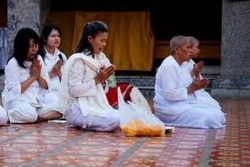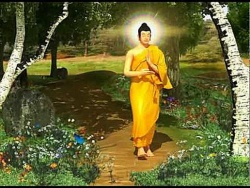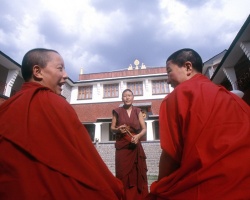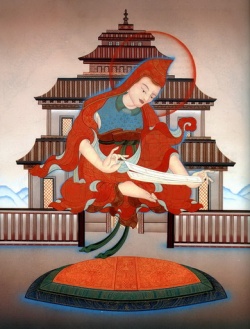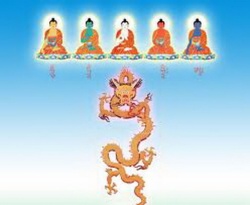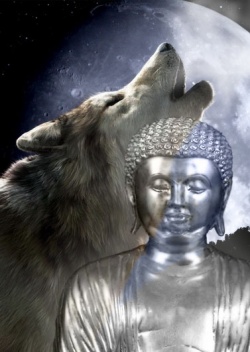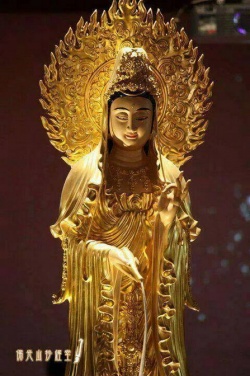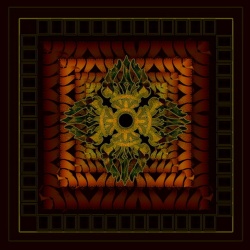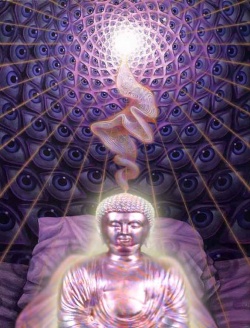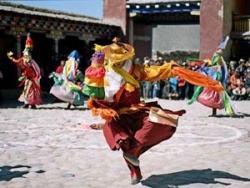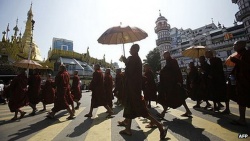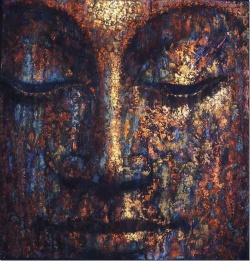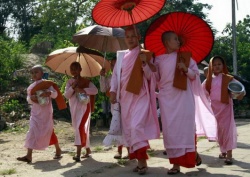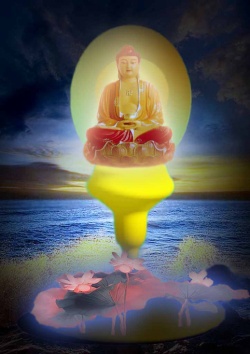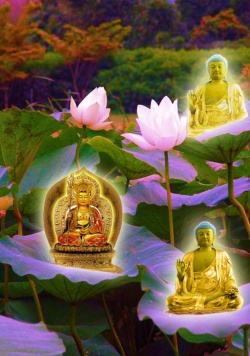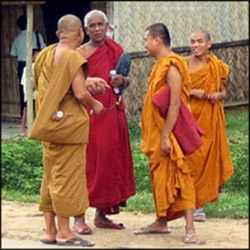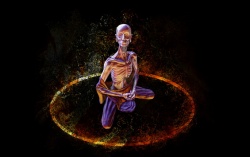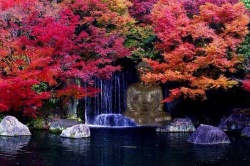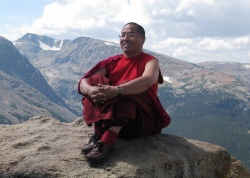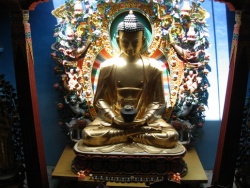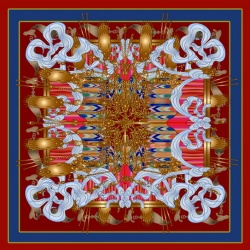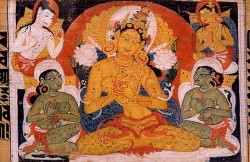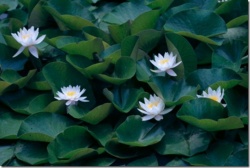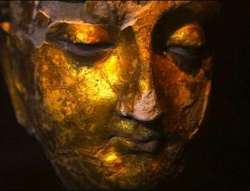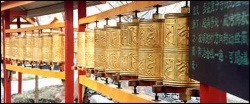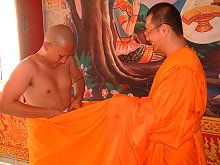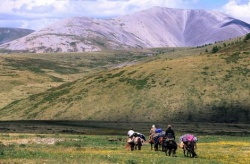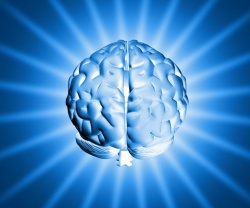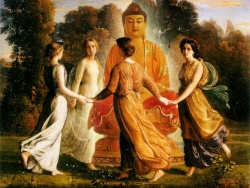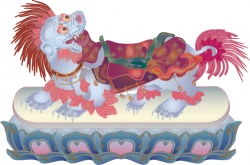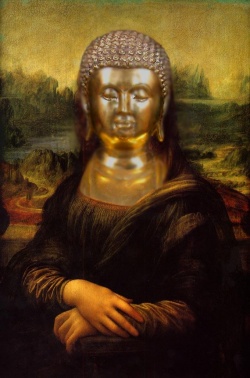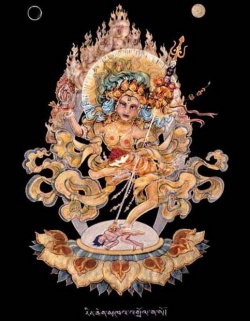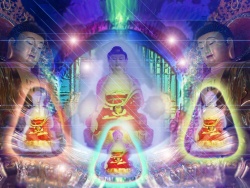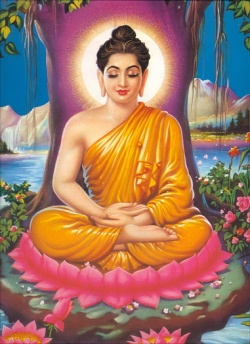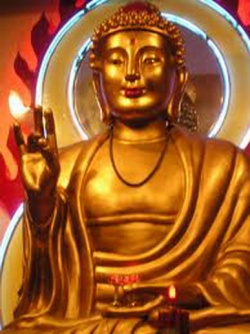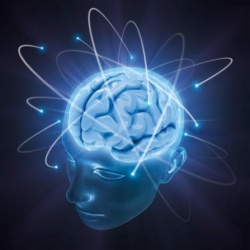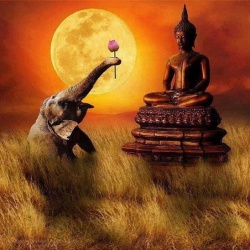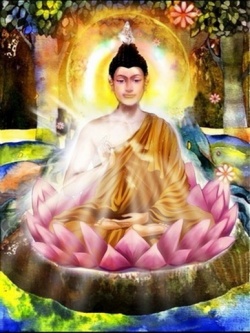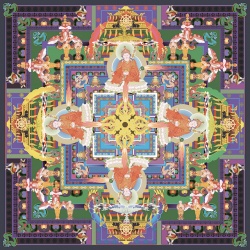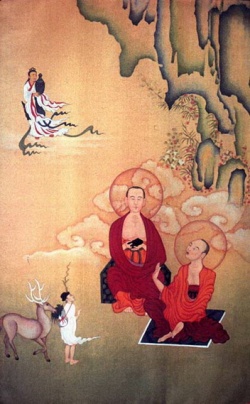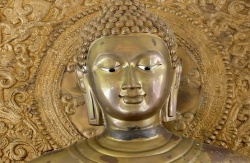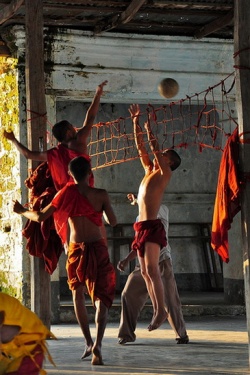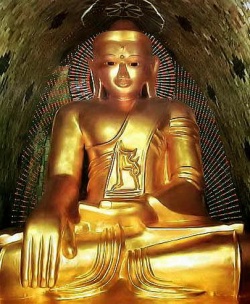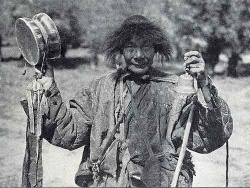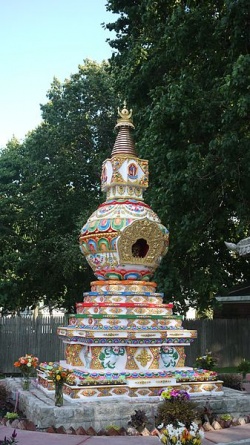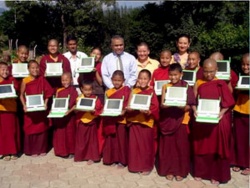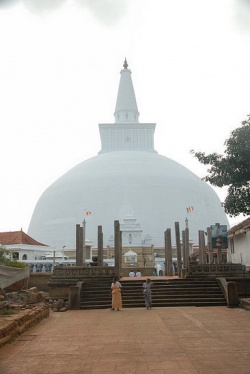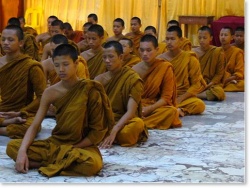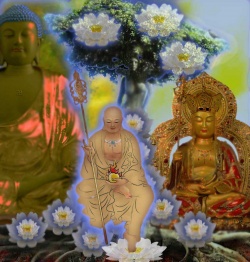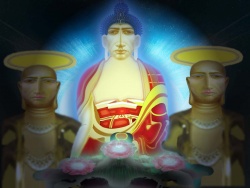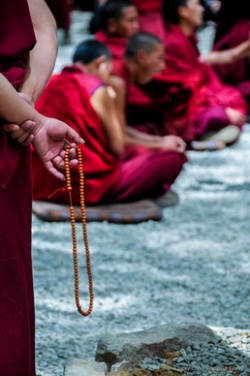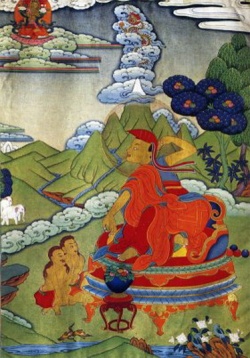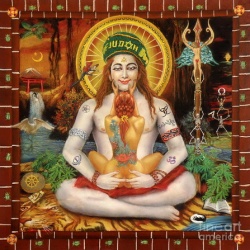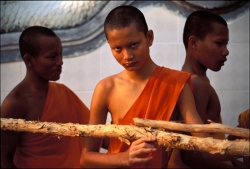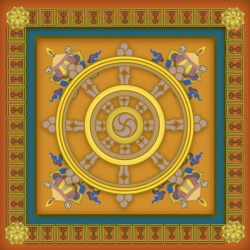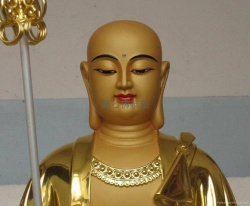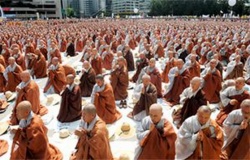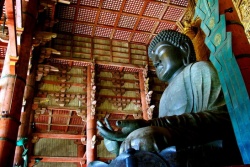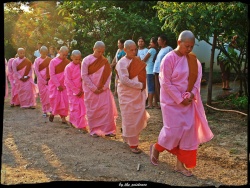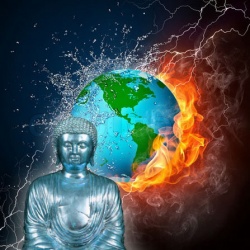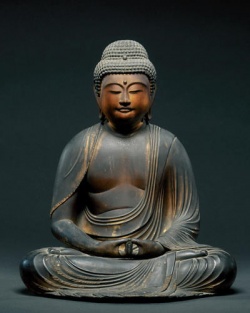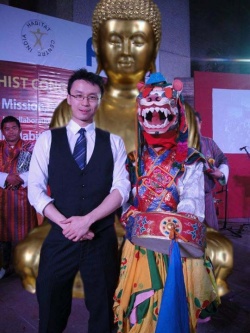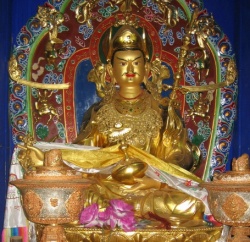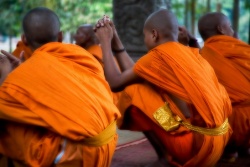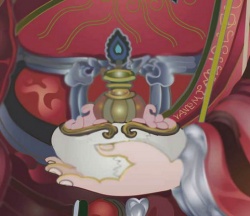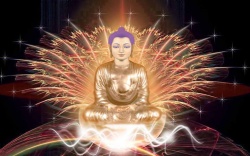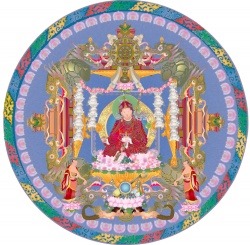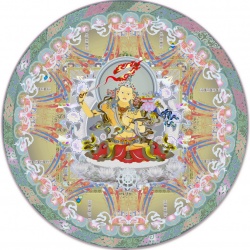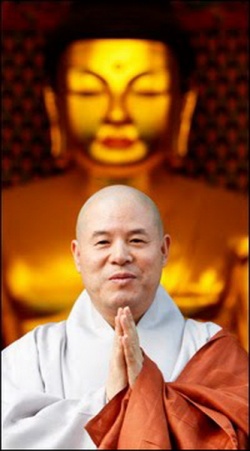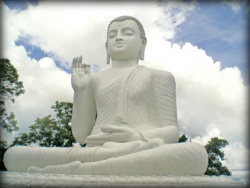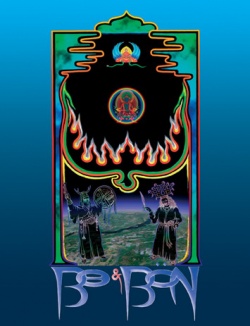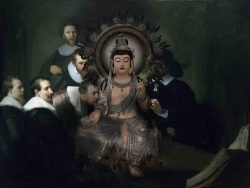Dharmacakrapravartanasūtram: The Discourse that Set the Dharma-Wheel Rolling (from Lalitavistara)
Dharmacakrapravartanasūtram
The Discourse that Set the Dharma-Wheel Rolling
from Lalitavistara[1]
edited & translated by
Ānandajoti Bhikkhu
(August 2009)
Introduction
note that in August of 2009 I have expanded the original text and translation of the verses only to include a text and translation of the Nidāna and the Sūtra also.
The following text has been established through a comparison of S. Lefman's edition of Lalitavistara of 1902 with P. L. Vaidya's edition of 1958. Both are published in Devanāgarī script. For a few verses I have also consulted F. Edgerton's edition in his Buddhist Hybrid Sanskrit Reader of 1953. An invaluble resource has been the same author's Buddhist Hybrid Sanskrit Dictionary also published in 1953.
The discourse and verses that are reproduced below come as the culmination of the text known as the Lalitavistara (An Elaboration of the Play [of the Buddha)), a Vaipūlyasūtra that is one of the central texts of the Mahāyāna, which was probably finalised in the first centuries of the Common Era. According to Nariman [2] it is based on a text that originally belongs to the Sarvāstivādī school.
The sūtra follows the Bodhisattva from his decision to leave the Tuṣita Heaven, though his birth, going-forth, and Awakening and ends with his teaching what would be known as the Dharmacakrapravartanasūtra. Here I have included the Meeting at Ṛṣipatana, which is much the same as the parallel story found in the Pāḷi Vinayapiṭaka, then the Discourse itself, which also is very close to the Pāḷi version, but with some interesting variations which I have recorded in the notes, and the verses that follow, which offer an alternative ending to the first teaching.
The verses add additional teachings to that outlined by that discourse, including the teachings on impermanence, emptiness, conditional origination, and the selfless nature of all phenomena, and so it constitutes a summary of the teaching, which is well worth a greater audience than it has so far received.
A number of the verses are quite obscure, and I have noted these in the text which follows in the hope that someone will be able to enlighten me on these matters. I have added the metrical markers and shown by the use of breves how I believe the text needs to be scanned, as this clearly shows that underneath the Sanskritisation of the text lie ancient verses written in a kind of Prākṛt that cannot be too far removed from the original dialect(s). This therefore reveals that although the text has received great elaboration at the hands of its redactors there is still an ancient core that must have been passed down in Buddhist monastic circles from the earliest times.
Acknowledgement
I am very grateful again to Rod Bucknell who kindly went through the whole work for me and made a number of useful suggestions and corrections, which has helped me to correct and clarify the presentation of this work.
Ānandajoti Bhikkhu
August, 2009
Ṛṣpatanasaṁgamanam
1: The Meeting at Ṛṣipatana
Iti hi bhikṣavas-Tathāgato 'nupūrveṇa Janapadacaryāṁ caran
Thus, monks, the Realised One while walking on walking tour through the (various) States
yena Vārāṇasī mahānagarī tenopasaṁkrāmat, upasaṁkramya kālyam-eva [3] nivāsya,
approached the great city of Vārāṇasī, and after approaching, dressing at the right time,
pātracīvaram-ādāya Vārāṇasīṁ mahānagarīṁ piṇḍāya prāvikṣat,
picking up his bowl and robe, he entered the great city of Vārāṇasī for alms, [4]
tasyāṁ piṇḍāya caritvā, kṛtabhaktakṛtyaḥ paścād-bhaktapiṇḍapātrapratikrāntaḥ,
after walking for alms there, when he was returning from the alms-round after the meal,
yena Ṛṣipatano Mṛgadāvo yena ca pañcakā bhadravargīyās-tenopasaṁkrāmati sma.
he approached the Deer Park in Ṛṣipatana and the auspicious group-of-five.
Adrākṣuḥ khalu punaḥ pañcakā bhadravargīyās-Tathāgataṁ dūrata evāgacchantaṁ
The auspicious group-of-five saw the Realised One coming from afar
dṛṣṭvā ca kriyābandham-akārṣuḥ:
and after seeing (him) they stopped what they were doing, (and said):
“Eṣa sa āyuṣmanta śramaṇo Gautama āgacchati sma,
“That ascetic Gautama who is coming, friends,
śaithiliko bāhulikaḥ pradhāṇavibhraṣṭaḥ.
is loose, given to luxury, has forsaken the striving.
Anena khalvapi tayāpi tāvat-pūrvikayā duṣkaracaryayā
Even when formerly living an austere life
na śakitaṁ kiṁcid-uttarimanuṣyadharmād-alam-āryajñānadarśanaviśeṣaṁ sākṣāt-kartuṁ,
he was not able to experience for himself a state beyond (ordinary) human beings, a distinction of what is truly noble knowledge and insight,
kiṁ punar-etarhir-audārikam-āhāram-āharan sukhallikāyogam-anuyukto viharan? [5]
so how now, when he lives with devotion and clinging to bringing in food for the gross material body?
Abhavyaḥ khalveṣa śaithiliko bāhulikaḥ. [6]
It is unsuitable, he is loose and given to luxury.
Nāsya kenacit-pratyudgantavyaṁ na pratyutthātavyam,
No one should go out to meet him, or rise up for him,
na pātracīvaraṁ pratigrahītavyaṁ nāśanaṁ dātavyaṁ na pānīyaṁ paribhogyaṁ,
or take his bowl and robes, or give him a seat, or give him a drink,
na pādapratiṣṭhānaṁ sthāpayitvātiriktāny-āsanāni, vaktavyaṁ ca:
or set up a footstool, (but) after putting out extra seats, he should be told:
‘Saṁvidyantaḥ [7] imāny-āyuṣman Gautama atiriktāny-āsanāni, [8] saced-ākāṅkṣasi niṣīdeti.’ ”
‘Know that these are extra seats friend Gautama, if you wish you can sit down.’ ”
Āyuṣmāṁs-tv-Ājñānakauṇḍinyaś-cittena nādhivāsayati [9] sma, vācā ca na pratikṣipati sma.
Venerable Ājñāna Kauṇḍinya could not endure it in his mind, but nor could he oppose it.
Yathā yathā ca bhikṣavas-Tathāgato yena pañcakā bhadravargīyās-tenopasaṁkrāmati sma
As, monks, the Realised One was approaching the auspicious group-of-five
tathā tathā te svakasvakeṣvāsaneṣu na ramante sma, utthātukāmā abhūvan.
they took no delight on being on their seats, and had a desire to rise.
Tad-yathāpi nāma pakṣī śakuniḥ pañjaragataḥ syāt,
Just as a bird inside a cage
tasya ca pañjaragatasyādho 'gnir-dagdho bhavet
when the bottom of the cage is consumed by fire
so 'gnisaṁtaptas-tvaritam-ūrdhvam-utpatitukāmo bhavet-pratretukāmaś-ca,
wishes to rise up quickly and wishes to escape the heat of the fire,
evam-eva yathā yathā Tathāgataḥ
just so, monks, as the Realised One
pañcakānāṁ bhadravargīyāṇāṁ sakāśam-upasaṁkrāmati sma,
was approaching near to the auspicious group-of-five
tathā tathā pañcakā bhadravargīyāḥ [10] svakasvakeṣvāsaneṣu na ramante sma,
so they took no delight on being on their seats,
utthātukāmā abhūvan.
and had a desire to rise.
Tat-kasmāt?
Why is that?
Na sa kaścit-sattvaḥ sattvanikāye saṁvidyate
There is no being in the (various) classes of beings
yas-Tathāgataṁ dṛṣṭvā, āsanān-na pratyuttiṣṭhet.
who, having seen the Realised One, does not rise from their seat.
Yathā yathā ca Tathāgataḥ pañcakān bhadravargīyānupasaṁkrāmati sma,
Just as the Realised One was approaching the auspicious group-of-five
tathā tathā pañcakā bhadravargīyās-Tathāgatasya śriyaṁ tejaś-cāsahamānā
so the auspicious group-of-five were unable to bear the glory and majesty of the Realised One,
āsanebhyaḥ prakampyamānāḥ sarve kriyākāraṁ bhittvā,
trembling they rose from their seats, and having broken their agreement,
cotthāyāsanebhyaḥ kaścit-pratyudgacchati sma,
and rising someone went out to meet him,
kaścit-pratyudgamya pātracīvaraṁ pratigṛhnāti sma,
someone rose up for him and took his bowl and robes,
kaścid-āsanam-upanāmayati sma, kaścit-pādapratiṣṭhāpanaṁ
someone offered him a seat, someone set up a footstool,
kaścit-pādaprakṣālanodakam-upasthāpayati sma, evaṁ cāvocat:
someone set up water for washing his feet, and they said:
“Svāgataṁ te āyuṣman Gautama,
“Welcome to you friend Gautama,
svāgataṁ te āyuṣman Gautama niṣīdedam-āsanaṁ prajñaptaṁ.”
welcome to you friend Gautama, please sit down on the prepared seat.”
Nyaṣīdat-khalvapi bhikṣavas-Tathāgataḥ prajñapta evāsane.
Then the Realised One, monks, sat down on the prepared seat.
Pañcakāpi bhadravargīyāste Tathāgatena sārdhaṁ vividhāṁ saṁmodanīṁ
The auspicious group-of-five exchanged with the Realised One some polite
saṁrañjanīṁ kathāṁ kṛtvaikānte niṣeduḥ ekānte niṣaṇṇāś-ca
and pleasing talk while seated, and while sitting on one side
te pañcakā bhadravargīyās-Tathāgatam-etad-avocan:
the auspicious group-of-five said this to the Realised One:
“Viprasannāni te āyuṣman Gautamendriyāṇi,
“Your faculties, friend Gautama, are very clear,
pariśuddhaś-chavivarṇa, paryavadātaṁ [11] mukhamaṇḍalan-tad-asti te āyuṣman Gautama,
purified is your skin and bright, the complexion of your face is pure, have you, friend Gautama,
kaścid-uttarimanuṣyadharmād-alam-āryajñānadarśanaviśeṣaḥ sākṣāt-kṛtaḥ?”
experienced for yourself a state beyond (ordinary) human beings, a distinction of what is truly noble knowledge and insight?”
Evam-ukte bhikṣavas-Tathāgataḥ pañcakān bhadravargīyānevam-āha:
After that was said, monks, the Realised One said this to the auspicious group-of-five:
“Mā yūyaṁ bhikṣavas-Tathāgatam-‘āyuṣmad’-vādena samudācariṣṭa,
“Do not, monks, address the Realised One by the word ‘friend’,
mā vo 'bhūd-dīrgharātram-arthāya hitāya sukhāya,
that will not be for your welfare, benefit and happiness for a long time,
Amṛtaṁ mayā bhikṣavaḥ sākṣāt-kṛto 'mṛtagāmī ca Mārgaḥ,
the Deathless has been experienced by me, monks, and the Path to the Deathless,
Buddho 'ham-asmi bhikṣavaḥ sarvajñaḥ sarvadarśī śītībhūto 'nāśravaḥ,
I am an Awakened One, monks, all-knowing, all-seeing, one who has cooled off, without pollutants,
vaśī sarvadharmeṣu Dharmam-ahaṁ bhikṣavo deśayiṣyāmi, [12]
I have power over all things, and I teach the Doctrine, monks,
āśu gacchata śṛṇuta pratipadyadhvaṁ śrotam-avadadhatāham [13]-avavadāmyanuśāsmi,
you should come, listen, undertake and give an ear, I am advising and instructing,
yathā mayā samyag-avavaditāḥ samyag-anuśiṣṭā,
having been properly instructed by me, properly trained,
yūyam-apyāśravāṇāṁ cetovimuktiṁ prajñāvimuktiṁ ca,
you will be free from the pollutants, freed in mind, freed through wisdom,
dṛṣṭa eva dharmaṁ sākṣāt [14]-kṛtvopasaṁpadya pravedayiṣyatha:
and in this very life, having seen directly, having attained, you will be able to say:
‘Kṣīṇā no jātir-uṣitaṁ ca brahmacaryam,
‘Destroyed is (re)birth for us, accomplished is the spiritual life,
kṛtaṁ karaṇīyam,
done is what ought to be done,
nāparam-ityato 'nyad-bhavaṁ - prajānāma’. iti
there is no more of this mundane state - this we know’.
Nanu ca yuṣmākaṁ bhikṣava etad-abhūt:
Now didn't this occur to you:
‘Ayaṁ khalv-Āyuṣmanta āgacchati śramaṇo Gautamaḥ,
‘This ascetic Gautama who is coming, friends,
śaithiliko bāhulikaḥ pradhānavibhraṣṭaḥ. [15]
is loose, given to luxury, has forsaken the striving.
Anena khalvapi tayāpi tāvat-pūrvikayā duṣkaracaryayā
Even when formerly living an austere life
na śakitaṁ kiṁcid-uttarimanuṣyadharmād-alam-āryajñānadarśanaviśeṣaṁ sākṣāt-kartuṁ,
he was not able to experience for himself a state beyond (ordinary) human beings, a distinction of what is truly noble knowledge and insight,
kiṁ punar-etarhir-audārikam-āhāram-āharan-sukhallikāyogam-anuyukto viharann?
so how now, when he lives with devotion and clinging to bringing in food for the gross material body?
Abhavyaḥ khalveṣa śaithiliko bāhuliko.
It is unsuitable, he is loose and given to luxury.
Nāsya kenacit-pratyudgantavyaṁ na pratyutthātavyam,
No one should go out to meet him, or rise up for him,
na pātracīvaraṁ pratigrahītavyaṁ nāśanaṁ dātavyaṁ na pānīyaṁ paribhogyaṁ,
or take his bowl and robes, or give him a seat, or give him a drink,
na pādapratiṣṭhānaṁ sthāpayitvātiriktāny-āsanāni vaktavyaṁ ca:
or set up a footstool, (but) after putting out extra seats he should be told:
“Saṁvidyantaḥ imāny-āyuṣman-Gautamātiriktāny-āsanāni, saced-ākāṅkṣasi niṣīdeti.” '
“Know that these are extra seats friend Gautama, if you wish you can sit down.” '
Teṣāṁ ca ehi bhikṣava ityukte yat-kiṁcit-tīrthikaliṅgaṁ tīrthikadhvajaḥ,
And having said ‘Come monks!’ to them, whatever signs or marks of their belonging to an outside sect they had
sarvo 'sau tat-kṣaṇam-evāntaraghāt-tricīvaraṁ pātraṁ ca prādurabhūt-tadanu,
all of them in an instant were destroyed, and thereupon the three robes and bowl appeared,
chinnāś-ca keśāḥ tad-yathāpi nāma varṣaśatopasaṁpannasya bhikṣor-īryāpathaḥ,
their hair was shorn, and their deportment was like monks who have been ordained for a hundred years,
saṁvṛtto 'bhūt-saiva ca teṣāṁ pravrajyābhūt-saivopasaṁpad-bhikṣubhāvaḥ.
they were restrained, and this was their going-forth, their higher ordination, their monkhood.
In Lalitavistara about six pages of text are found here in which the Buddha decides where to teach, which is followed by many signs and wonders, and a gathering of the gods from all over the universe who request him to set the Dharma-Wheel rolling, at which point he sits down and delivers his first discourse:
==Dharmacakrapravartanasūtram] [16]
2: The Discourse that Set the Dharma-Wheel Rolling==
Iti hi bhikṣavas-Tathāgato rātryāḥ prathame yāme tūṣṇībhāvenādhivāsayati sma, Then the Realised One, monks, in the first watch of the night agreed (to teach) by keeping silent,
rātryā madhyame yāme saṁrañjanīyāṁ kathāṁ pravartayati sma, in the middle watch of the night he took delight in what was to be said,
rātryāḥ paścime yāme pañcakān bhadravargīyān-āmantryaitad-avocat: in the last watch of the night he addressed the auspicious group-of-five, (saying):
Dvāvimau bhikṣavaḥ pravrajitasyāntāvakramau, “There are these two extremes, monks, that one who has gone forth ought not to descend to,
yaś-ca: kāmeṣu kāmasukhallikā yogo hīno grāmyaḥ pārthagjaniko, which is this: being joined and clinging to the pleasure in sense pleasures, which is low, vulgar, worldly,
nālam-āryo 'narthopasaṁhito nāyatyāṁ brahmacaryāya, not very noble, not connected with the goal, not (helpful) for the spiritual life in the future,
na nirvide [17] na virāgāya na nirodhāya nābhijñāya, not leading to world-weariness, dispassion, cessation, deep knowledge,
na Saṁbodhaye na Nirvāṇāya saṁvartate; Complete Awakening, and Emancipation;
yā ceyam-amadhyamā pratipad-ātmakāyaklamathānuyogo [18] duḥkho 'narthopasaṁhito, and this, which is not the middle practice: devotion to self-mortification, which is painful, not connected with the goal,
dṛṣṭadharmaduḥkhaś-cāyatyāṁ ca duḥkhavipākaḥ. painful in this very life and in the future where it results in pain.
Etau ca bhikṣavo dvāvantāvanupagamya Not having approached either of these two extremes, monks,
madhyamayaiva pratipadā Tathāgato Dharmaṁ deśayati, yaduta: the Doctrine of the middle practice is being taught by the Realised One, which is this:
samyag-dṛṣṭiḥ right view
samyak-saṁkalpaḥ right thought
samyag-vāk- right speech
samyak-karmāntaḥ right action
samyag-ājīvaḥ right livelihood
samyag-vyāyāmaḥ right endeavour
samyak-smṛtiḥ right mindfulness
samyak-samādhir-iti. right concentration.
The Four Noble Truths
Catvārīmāni bhikṣava Āryasatyāni. There are these Four Noble Truths, monks.
Katamāni catvāri? Which four?
Duḥkhaṁ, duḥkhasamudayo, duḥkhanirodho, duḥkhanirodhagāminī pratipat. Suffering, the arising of suffering, the cessation of suffering, and the practice leading to the cessation of suffering.
Tatra katamad-duḥkham? Herein, what is suffering?
jātir-api duḥkhaṁ birth is suffering
jarāpi duḥkhaṁ also old age is suffering
vyādhir-api duḥkhaṁ also sickness is suffering
maraṇam-api apriyasaṁprayogo 'pi priyaviprayogo 'pi duḥkham also death, being joined to what is not dear, being separated from what is dear, is suffering
yad-api icchan paryeṣamāṇo na labhate tad-api duḥkham also not to obtain what one seeks for is suffering
saṁkṣepāt pañcopādānaskandhā duḥkham in brief, the five constituent parts (of mind and body) that provide fuel for attachment are suffering.
Idam-ucyate duḥkham. This is said to be suffering.
Tatra katamo duḥkhasamudayaḥ? Herein, what is the arising of suffering?
Yeyaṁ tṛṣṇā paunarbhavikī, it is that craving which leads to continuation in existence,
nandīrāgasahagatā tatratatrābhinandinī. which is connected with enjoyment and passion.
Ayam-ucyate duḥkhasamudayaḥ. This is said to be the arising of suffering.
Tatra katamo duḥkhanirodhaḥ? Herein, what is the cessation of suffering?
Yo 'syā eva tṛṣṇāyāḥ punar-bhavikyā nandīrāgasahagatāyās-tatra-tatrābhinandinyā o It is the complete fading away and cessation without remainder of the birth of that craving, which greatly enjoys this and that,
janikāyā nirvartikāyā aśeṣo virāgo nirodhaḥ. and is connected with enjoyment and passion.
Ayaṁ [19] [[[ucyate]]] duḥkhanirodhaḥ. This is [said to be] the cessation of suffering.
Tatra katamā duḥkhanirodhagāminī pratipat? Herein, what is the practice leading to the cessation of suffering?
Eṣa evāryāṣṭāṅgamārgaḥ tad-yathā: It is the noble eightfold path, which is this:
samyag-dṛṣṭiḥ right view
samyak-saṁkalpaḥ right thought
samyag-vāk- right speech
samyak-karmāntaḥ right action
samyag-ājīvaḥ right livelihood
samyag-vyāyāmaḥ right endeavour
samyak-smṛtiḥ right mindfulness
samyak-samādhir-iti. [20] right concentration.
Idam-ucyate duḥkhanirodhagāminī pratipad-āryasatyam-iti. This is said to be the noble truth of the practice leading to the cessation of suffering.
Imāni bhikṣavaś-catvāryāryasatyāni. These, monks, are the four noble truths. </poem>
Realisation
‘Iti duḥkham’-iti,
‘This is suffering’,
me bhikṣavaḥ pūrvam-aśruteṣu dharmeṣu
to me, monks, regarding these previously unheard-of things
yoniśomanasikārād-bahulīkārāj-jñānam-utpannaṁ,
reflecting wisely and practising continuously, knowledge arose,
cakṣur-utpannaṁ vidyotpannā bhūrir-utpannā,
vision arose, understanding arose, comprehension arose,
medhotpannā prajñotpannā ālokaḥ prādur-bhūtaḥ.
intelligence arose, wisdom arose and light became manifest.
‘Ayaṁ duḥkhasamudaya’ iti,
‘This is the arising of suffering’, [21]
me bhikṣavaḥ pūrvam-aśruteṣu dharmeṣu
to me, monks, regarding these previously unheard-of things
yoniśomanasikārād-bahulīkārāj-jñānam-utpannaṁ,
reflecting wisely and practising continuously, knowledge arose,
cakṣur-utpannaṁ vidyotpannā bhūrir-utpannā,
vision arose, understanding arose, comprehension arose,
medhotpannā prajñotpannā ālokaḥ prādur-bhūtaḥ.
intelligence arose, wisdom arose and light became manifest.
‘Ayaṁ duḥkhanirodha’ iti,
‘This is the cessation of suffering’,
me bhikṣavaḥ pūrvam-aśruteṣu dharmeṣu [22]
to me, monks, regarding these previously unheard-of things
yoniśomanasikārād-bahulīkārāj-jñānam-utpannaṁ,
reflecting wisely and practising continuously, knowledge arose,
cakṣur-utpannaṁ vidyotpannā bhūrir-utpannā,
vision arose, understanding arose, comprehension arose,
medhotpannā prajñotpannā ālokaḥ prādur-bhūtaḥ.
intelligence arose, wisdom arose and light became manifest.
‘Iyaṁ duḥkhanirodhagāminī pratipad’- iti,
‘This is the practice leading to the cessation of suffering’,
me bhikṣavaḥ pūrvam-aśruteṣu dharmeṣu
to me, monks, regarding these previously unheard-of things
yoniśomanasikārād-bahulīkārāj-jñānam-utpannaṁ,
reflecting wisely and practising continuously, knowledge arose,
cakṣur-utpannaṁ vidyotpannā bhūrir-utpannā,
vision arose, understanding arose, comprehension arose,
medhotpannā prajñotpannā ālokaḥ prādur-bhūtaḥ.
intelligence arose, wisdom arose and light became manifest.
Yat-khalvidaṁ ‘duḥkhaṁ parijñeyam’-iti,
Now that to which “this is suffering” refers (i.e. suffering itself) ought to be fully known,
me bhikṣavaḥ pūrvam-aśruteṣu dharmeṣu
to me, monks, regarding these previously unheard-of things
yoniśomanasikārād-bahulīkārāj-jñānam-utpannaṁ,
reflecting wisely and practising continuously, knowledge arose,
cakṣur-utpannaṁ vidyotpannā bhūrir-utpannā,
vision arose, understanding arose, comprehension arose,
medhotpannā prajñotpannā ālokaḥ prādur-bhūtaḥ.
intelligence arose, wisdom arose and light became manifest.
Sa khalvayaṁ ‘duḥkhasamudayaḥ prahātavya’ iti,
Now that to which “this is the arising of suffering” refers (i.e. craving) ought to be given up,
me bhikṣavaḥ pūrvam-aśruteṣu dharmeṣu
to me, monks, regarding these previously unheard-of things
yoniśomanasikārād-bahulīkārāj-jñānam-utpannaṁ,
reflecting wisely and practising continuously, knowledge arose,
cakṣur-utpannaṁ vidyotpannā bhūrir-utpannā,
vision arose, understanding arose, comprehension arose,
medhotpannā prajñotpannā ālokaḥ prādur-bhūtaḥ.
intelligence arose, wisdom arose and light became manifest.
Sa khalvayaṁ ‘duḥkhanirodhaḥ sākṣāt-kartavya’ iti,
Now that to which “this is the noble truth of the cessation of suffering” refers (i.e. Emancipation) ought to be experienced,
me bhikṣavaḥ pūrvam-aśruteṣu dharmeṣu
to me, monks, regarding these previously unheard-of things
yoniśomanasikārād-bahulīkārāj-jñānam-utpannaṁ,
reflecting wisely and practising continuously, knowledge arose,
cakṣur-utpannaṁ vidyotpannā bhūrir-utpannā,
vision arose, understanding arose, comprehension arose,
medhotpannā prajñotpannā ālokaḥ prādur-bhūtaḥ.
intelligence arose, wisdom arose and light became manifest.
Sā khalviyaṁ ‘duḥkhanirodhagāminī pratipad-bhāvayitavye’-ti,
Now that to which “this is the noble truth of the practice leading to the end of suffering” refers (i.e. the practice itself) ought to be developed,
me bhikṣavaḥ pūrvam-aśruteṣu dharmeṣu
to me, monks, regarding these previously unheard-of things
yoniśomanasikārād-bahulīkārāj-jñānam-utpannaṁ,
reflecting wisely and practising continuously, knowledge arose,
cakṣur-utpannaṁ vidyotpannā bhūrir-utpannā,
vision arose, understanding arose, comprehension arose,
medhotpannā prajñotpannā ālokaḥ prādur-bhūtaḥ.
intelligence arose, wisdom arose and light became manifest.
Tat-khalvidaṁ ‘duḥkhaṁ parijñātam’-iti,
Now that to which “this is the noble truth of suffering” refers has been fully known -
me bhikṣavaḥ pūrvam-aśruteṣu dharmeṣu
to me, monks, regarding these previously unheard-of things
yoniśomanasikārād-bahulīkārāj-jñānam-utpannaṁ,
reflecting wisely and practising continuously, knowledge arose,
cakṣur-utpannaṁ vidyotpannā bhūrir-utpannā,
vision arose, understanding arose, comprehension arose,
medhotpannā prajñotpannā ālokaḥ prādur-bhūtaḥ.
intelligence arose, wisdom arose and light became manifest.
Sa khalvayaṁ ‘duḥkhasamudayaḥ prahīṇa’ iti,
Now that to which “this is the noble truth of the arising of suffering” refers has been given up,
me bhikṣavaḥ pūrvam-aśruteṣu dharmeṣu
to me, monks, regarding these previously unheard-of things
yoniśomanasikārād-bahulīkārāj-jñānam-utpannaṁ,
reflecting wisely and practising continuously, knowledge arose,
cakṣur-utpannaṁ vidyotpannā bhūrir-utpannā,
vision arose, understanding arose, comprehension arose,
medhotpannā prajñotpannā ālokaḥ prādur-bhūtaḥ.
intelligence arose, wisdom arose and light became manifest.
Sa khalvayaṁ ‘duḥkhanirodhaḥ sākṣāt-kṛta’ iti,
Now that to which “this is the noble truth of the cessation of suffering” refers has been experienced,
me bhikṣavaḥ pūrvam-aśruteṣu dharmeṣu
to me, monks, regarding these previously unheard-of things
yoniśomanasikārād-bahulīkārāj-jñānam-utpannaṁ,
reflecting wisely and practising continuously, knowledge arose,
cakṣur-utpannaṁ vidyotpannā bhūrir-utpannā,
vision arose, understanding arose, comprehension arose,
medhotpannā prajñotpannā ālokaḥ prādur-bhūtaḥ.
intelligence arose, wisdom arose and light became manifest.
Sā khalviyaṁ ‘duḥkhanirodhagāminī pratipad-bhāvite’-ti,
Now that to which “this is the noble truth of the practice leading to the end of suffering” refers has been developed,
me bhikṣavaḥ pūrvam-aśruteṣu dharmeṣu
to me, monks, regarding these previously unheard-of things
yoniśomanasikārād-bahulīkārāj-jñānam-utpannaṁ,
reflecting wisely and practising continuously, knowledge arose,
cakṣur-utpannaṁ vidyotpannā bhūrir-utpannā,
vision arose, understanding arose, comprehension arose,
medhotpannā prajñotpannā ālokaḥ prādur-bhūtaḥ.
intelligence arose, wisdom arose and light became manifest.
Declaring the Awakening
Iti hi bhikṣavo yāvad-eva me eṣu caturṣvāryasatyeṣu
For as long as to me, monks, in regard to these four noble truths
yoniśo manasikurvato evaṁ triparivartaṁ dvādaśākāraṁ,
reflected upon wisely and turned like this, in three ways, twelvefold,
jñānadarśanam-utpadyate, na tāvad-ahaṁ bhikṣavo 'nuttarāṁ
knowledge and insight was (still) arising, for that long, monks, I did not declare
samyak-saṁbodhim-abhisaṁbuddho 'smi iti pratijñāsiṣam;
that I was fully awakened with unsurpassed complete awakening;
na ca me jñānadarśanam-utpadyate,
but when knowledge and insight was no longer arising,
yataś-ca me bhikṣava eṣu caturṣvāryasatyeṣvevaṁ triparivartaṁ dvādaśākāraṁ,
and in regard to these four noble truths, monks, turned like this, in three ways, twelvefold,
jñānadarśanam-utpannam:
knowledge and insight had arisen (and I knew):
akopyā ca me cetovimuktiḥ, prajñāvimuktiś-ca sākṣāt-kṛtā,
sure is my liberation of mind, wisdom and liberation have been experienced,
tato 'haṁ bhikṣavo 'nuttarāṁ
then I, monks, did declare
samyak-saṁbodhim-abhisaṁbuddho 'smi iti pratijñāsiṣam
that I was fully awakened with unsurpassed complete awakening
jñānadarśanaṁ me udapādi:
and knowledge and insight arose:
‘Kṣīṇā me jātir [23]-uṣitaṁ brahmacaryam,
‘Destroyed is (re)birth for me, accomplished is the spiritual life,
kṛtaṁ karaṇīyam,
done is what ought to be done,
nāparasmād-bhavaṁ' prajānāmi.
there is no more of this mundane state' - this I know.
Tatredam-ucyute.
This is what was said in that place.
==Dharmacakrapravartanagāthā [24]
3: Verses on Setting Rolling the Dharma-Wheel==
Vācāya Brahmaruta kinnaragarjitāya,
Having a voice resounding like Brahmā, like the song of a Kinnara, [25]
Aṁśaiḥ sahasranayutebhi samudgatāya,
Having ten-million [26] rays radiating (from his body),
Bahukalpakoṭi sada [27] satyasubhāvitāya,
Having cultivated truth continually for many millions of aeons, [28]
Kauṇḍinyam-ālapati Śākyamuniḥ [29] Svayaṁbhūḥ: [31]
The Self-made [30] Sage of the Śākyans addressed Kauṇḍinya:
“Cakṣur [31]-anityam-ădhruvaṁ tathă śrotăghrāṇaṁ, [32]
“The eye is impermanent, inconstant, and so is the ear, the nose,
Jihvā pi kāya mana duḥkhā [33] anātma śūnyā.
The tongue, the body, the mind --- (all) are suffering, non-self, empty.
Jaḍāsvabhāva tṛṇakuḍma ivā nirīhā,
Naturally quiescent like clumps of grass, inanimate,
Naivātra Ātma [34] na Naro na ca Jīvam-asti. [32]
There is neither Self here, nor a Person or a Soul. [35]
Hetuṁ pratītya imi saṁbhuta sarvadharmā,
All things are produced with a condition and a cause,
Atyantadṛṣṭivigatā gaganaprakāśā:
Having put aside all extreme views, (it is) as clear as the sky:
Na ca kārako 'sti, tatha naiva ca vedako 'sti,
There is no doer, nor is there one who experiences,
Na ca karma paśyati kṛtaṁ hyaśubhaṁ śubhaṁ vā. [33]
He sees no deed done, whether it be bad or good.
Skandhā pratītya samudeti, hi duḥkham-evaṁ,
The constituent parts [36] arise through conditions, and so there is suffering,
Saṁbhonti tṛṣṇasalilena vivardhamānā.
It is produced just as thirst is through the cutting off of water.
Mārgeṇa Dharmasamatāya vipaśyamānā,
Seeing equanimity towards (conditioned) things through the Path,
Atyantăkṣīṇakṣayadharmatayā [37] niruddhāḥ [34]
It is completely destroyed, with the cessation of those things subject to decay.
Saṁkalpakalpajanitena ayoniśena
With the production of various thoughts that are not wise
Bhavate avidya, na pi saṁbhavako 'sya kaści,
Comes ignorance, [38] no one is a producer of it,
Saṁskārahetu dadate, na ca saṁkramo 'sti,
The cause for volitional (processes) is given, [39] there is no maker of them,
Vijñānam-udbhavati saṁkramaṇaṁ pratītya, [35]
Consciousness arises, made by conditions,
Vijñāna nāma tatha [40] rūpa samutthitāsti,
With consciousness there is then an arising of name and form,
Nāme ca rūpi samudenti ṣaḍ-indriyāṇi,
With name and form originate the six sense spheres,
Ṣaḍ [41]-indriyair-nipatito itĭ sparśa uktaḥ,
Contact is said to fall upon the six sense spheres,
Sparśena tisra anuvartati vedanā ca, [36]
With contact the three feelings follow along,
Yat-kiṁci vedayitu sarva satṛṣṇa uktā,
Whatever feelings there are, all are said to be joined with craving,
Tṛṣṇāta sarva upajāyati duḥkhaskandhaḥ,
From craving is born a whole mass of suffering,
Upādānato bhavati sarva bhavapravṛttiḥ,
From attachment comes the whole round of existence,
Bhavăpratyayā ca samudeti hi jātir-asya, [37]
Because of continuation of existence birth arises for him,
Jātīnidāna jarăvyādhidŭḥkhāni bhonti,
With birth as foundation come the sufferings of old-age and sickness,
Upapatti naika vividhā bhavapañjare 'smiṁ. [42]
And many and various rebirths in the round of existence.
Evam-eṣa [43] sarva itĭ pratyayato jagasya,
Thus from all these conditions there are worldly inhabitants,
Na ca Ātma Puṅgalu [44] na samkramako 'sti kaści. [38]
There is no Self or Person encountered anywhere.
Yasmin-na kalpu na vikalpu [45] yonim-āhuḥ,
Where there is no imagining or doubt that is said to be wisdom,
Yad-yoniśo bhavati [46] na tatra avidya kāci.
Whatever comes from wisdom, in that there is no ignorance at all.
Yasmin-nirodhu bhavatīha avidyatāyāḥ
In whatever place there is cessation of ignorance
Sarve bhavāṅgăkṣayăkṣīṇăkṣayaṁ [47] niruddhā. [39]
There is a cessation of all decay and the factors of existence which are destroyed by decay. [48]
Evam-eṣă pratyayata buddha Tathāgatena,
Thus conditionality has been understood by the Realised One,
Tena Svayaṁbhŭ svakamātmanŭ vyākaroti.
Because of that the Self-made One declares himself (Awake).
Na skandha āyatana dhātu vademi Buddhaṁ,
I do not say that the constituent parts, the sense-spheres, or the elements are the Buddha,
Nānyatra hetvavagamādbhavatīha Buddhaḥ. [40]
Without an understanding of conditions no-one can become a Buddha.
Bhūmir-na cātra paratīrthika niḥsṛtānāṁ, [49]
There is no room here for those who have gone forth as heretics,
Śūnyā pravādi iha īdṛśa dharmayoge,
When speaking of emptiness in connection with such things,
Ye pūrva-Buddhacaritā suviśuddhasattvāḥ,
(Only) those who are fully purified beings, who live (like) former Buddhas,
Te śaknuvanti imi Dharma vijānanāya.” [41]
Who speak pleasantly, get to know the Nature (of things).”
Evaṁ hi dvādaśākāraṁ Dharmacakraṁ pravartitaṁ,
Thus the Dharma-Wheel (understood) in twelve ways was set rolling,
Kauṇḍinyena ca ājñātaṁ nirvṛttā ratanā trayaḥ. [42]
It was understood by Kauṇḍinya, and the three jewels came into existence. [50]
Buddho Dharmaś-ca Saṁghaś-ca ityetad-ratanatrayaṁ,
The Buddha, the Dharma and the Saṅgha, these are the three jewels,
Parasparāṁgataḥ śabdo yāvad-Brahmapurālayaṁ. [43]
This cry passed from one to another as far as the Brahmā realm.
Vartitaṁ virajaṁ Cakraṁ Lokanāthena tāyinā,
The dust-free (Dharma) Wheel was set rolling by the Lord of the World,
Utpannā ratanā trīṇi loke paramadurlabhā. [44]
And the three jewels, which are exceedingly rare, arose in the world.
Kauṇḍinyaṁ prathamaṁ kṛtvā, pañcakāś-caiva bhikṣavaḥ
Having first converted Kauṇḍinya, the five monks
Ṣaṣṭīnāṁ devakoṭīnāṁ Dharmacakṣur-viśodhitaṁ, [45]
And six hundred million gods were purified by the Vision-of-the-Dharma, [51]
Anye cāśītikoṭyastu Rūpadhātukadevatāḥ
And another eight hundred million gods from the Element of Form [52]
Teṣāṁ viśodhitaṁ cakṣu Dharmacakrapravartane. [53] [46]
Had their vision purified by the Dharma-Wheel being set rolling.
Catur-aśītisahasrāṇi manuṣyāṇāṁ samāgatā
Eighty-four thousand human beings who had assembled
Teṣāṁ viśodhitaṁ cakṣu, muktā sarvebhi durgatī. [47]
Also had their vision purified, and were freed from all bad destinations. [54]
Daśadiśatu ananta Buddhasvaro gacchi tasmiṁ kṣaṇe,
At that moment in the ten directions [55] without end this cry (concerning) the Buddha went forth,
Ruta madhura manojña, saṁśrūyate [56] cāntarīkṣe śubha:
Resounding, sweet, pleasing, beautiful, it was heard in the firmament:
“Eṣa [57] daśabalena Śākyarṣiṇā Dharmacakrottamaṁ,
o “The supreme Dharma-Wheel, has been set rolling by the One Possessing Ten-Powers, by the Śākyan sage,
Ṛṣipatanam-upetya Vārāṇasī vartito nānyathā. [48]
By no other, after he had approached Ṛṣipatana, close to Vārāṇasī.”
Daśa diśitayi keci Buddhaśatā [58] sarvi tūṣṇībhutāḥ,
In the ten directions all of the hundred Buddhas [59] fell silent,
Teṣa muninaye upasthāyakāḥ sarvi pṛcchī Jināṁ:
And the leading sages who attended on them all asked the Victorious Ones:
“Kim-iti Daśabalebhi Dharmākathā chinnă śrutvā rutaṁ?
“Why have the Ones Possessing Ten-Powers after hearing this sound, interrupted their Dharma talk thus?
Sādhu bhaṇata śīghra kiṁ kāraṇaṁ tūṣṇībhāvena sthitāḥ?” [60] [49]
What is the reason they have so quickly silenced their speech?”
“Purvabhavaśatebhi vīryābalai Bodhi samudāniyā, [61]
“Through a hundred previous existences Awakening was accomplished with energy and strength,
Bahava śatasahasra paścān-mukhā Bodhisattvā kṛtāḥ.
And many hundred-thousand Buddhas-to-be were left behind.
Tena hitakareṇa uttaptatā prāpta Bodhiḥ śivā,
So through beneficial actions and purification [62] the auspicious Awakening was attained,
Cakră triparivartă prāvartitā tena tūṣṇībhutāḥ.” [50]
The Wheel has been rolled three times, [63] therefore we have become silent.”
“Imu vacană śruṇitva [64] teṣāṁ munīsattvakoṭyaḥ śatā,
“After hearing these words, those billions [65] of sages,
Maitrabala janitva saṁprasthitā Agrabodhiṁ śivāṁ.
After developing the strength of friendliness, advanced towards the auspicious and highest Awakening, (thinking):
“Vayam-api anuśikṣi tasyā Mune vīryăsthāmodgataṁ,
“We also will train under the Sage, engaged in giving rise to energy,
Kṣipra bhavĕma loki lokottamā, Dharmacakṣur-dadāḥ.” [51] iti //
Quickly we will become supreme in the world, and will offer the Vision-of-the-Dharma (to others).”
At this point in Lalitavistara there is a long prose passage which begins with the Bodhisattva Maitreya asking the Buddha to explain more about the rolling of the Dharma-Wheel. It begins as a panegyric on the Wheel itself, and then goes into a long list of titles that the Buddha is known by, which spans some 14 pages in Lefman's edition, before the verses are taken up again:
Gambhīraṁ durdṛśaṁ sūkṣmaṁ Dharmacakraṁ pravartitaṁ,
The deep, hard to see, subtle Dharma-Wheel has been set rolling,
Yatra Mārā na gāhante sarve ca paratīrthikāḥ. [52]
Which the Māras cannot grasp, nor any of the outside heretics.
Anālayaṁ niṣprapañcaṁ anutpādam-asaṁbhavaṁ
The non-adhering, non-proliferating, non-arising, non-producing
Viviktaṁ prakṛtīśūnyaṁ Dharmacakraṁ pravartitaṁ. [53]
Dharma-Wheel has been set rolling, which is pure, [66] and naturally empty.
Anāyūham-aniryūham-animittam-alakṣaṇaṁ,
Without effort and without leaving off effort, without signs and characteristics,
Samatādharmanirdeśaṁ Cakraṁ Buddhena varṇitaṁ. [54]
The Buddha praises the Wheel which explains the nature of equanimity.
Māyāmarīcĭ svapnaṁ ca dakacandra pratĭśrutkā -
A magical mirage, a dream, the moon in the water, an echo -
Yathaite tathā tac-Cakraṁ Lokanāthena vartitaṁ. [55]
Just so is the Wheel that was set rolling by the Lord of the World.
Pratītyadharma-otāram-anucchedam-aśāśvataṁ,
The entrance to (understanding) conditionality, which is neither annihilation nor eternalism,
Sarvadṛṣṭisamucchedo Dharmacakram-iti smṛtaṁ. [56]
The Dharma-Wheel, which cuts off all (wrong) views, is remembered as such.
Ākāśena sadā tulyaṁ nirvikalpaṁ prabhāsvaraṁ,
(Empty) forever like space, free from doubt, luminous,
Anantamadhyanirdeśaṁ Dharmacakram-ihocyate. [57]
The explanation of the middle (Path), free from extremes -- such is the Dharma-Wheel said to be.
Astināstivinir-muktam-Ātmyanair-ātmyavarjitaṁ,
Free from being and non-being, without Self or non-Self,
Prakṛtyā jātinirdeśaṁ Dharmacakram-ihocyate. [58]
The Dharma-Wheel is said to be the explanation of Nature and of birth.
Bhūtakoṭīm-akoṭīṁ ca tathatāyāṁ tathatvataḥ,
True from bottom to top, this is real and factual,
Advayo dharmanirdeśo Dharmacakraṁ nirucyate. [59]
The unique explanation of the nature (of things) - such is the Dharma-Wheel said to be.
Cakṣusvabhāvataḥ [67] śūnyaṁ śrotaṁ ghrāṇaṁ tathaiva ca
The state of the eye is empty, and so also with the ear, the nose,
Jihvā kāyaṁ ca cittaṁ ca śūnyātmāno nirīhakaḥ [60]
The tongue, the body and the mind --- they are empty of self, inanimate. [68]
Idaṁ tad-īddaśaṁ Cakraṁ Dharmacakraṁ pravartitaṁ,
This Wheel is such-like, the Dharma-Wheel that has been set rolling,
Bodhayatyabudhān-sattvāṁs-tena buddho nirucyate [61]
It Awakens the unawakened beings, therefore it is called the awakened (teaching).
Svayaṁ mayānubuddho 'yaṁ svabhāvo Dharmalakṣaṇaṁ
By myself the state and characteristic of Nature have been understood
Ṛte paropadeśena Svayaṁbhūs-tatha Cakṣumān. [62]
Without the teaching of others, (I am) therefore Self-made, a Visionary.
Sarvadharmavaśiprāpto Dharmasvāmī nirucyate,
I have attained mastery of all things, so am said to be the Lord of Dharma,
Nayānayajño dharmeṣu Nāyakas-tena cocyate. [63]
I am the knower of the right and wrong way in (all) things, therefore I am said to be the Leader. [69]
Yathā bhavanti vaineyā Vinayām-yamitāṁ janāṁ,
As there are unfriendly people I will discipline them in the Discipline,
Vineyapāramiprāptas-tena prokto Vināyakaḥ [64]
(I have) attained the discipline of perfection, therefore I am called the Great Leader.
Naṣṭamārgā hi ye sattvā Mārgaṁ deśemi uttamaṁ,
To those beings who have lost their way I point out the Path supreme,
Nayāmi pārimaṁ tīraṁ tasmād-asmi Vināyakaḥ [65]
And lead them to the farther shore, therefore I am the Great Leader.
Saṁgrahāvastujñānena saṁgṛhya janatām-ahaṁ
Through knowing the bases of sympathy [70] I welcome the people
Saṁsārāṭavinis-tīrṇaḥ Sārthavāhas-tato hyahaṁ. [66]
Crossing through the forest of the Cycle (of birth and death), therefore I am the Caravan-Leader.
Vaśavartī sarvadharmeṣu tena Dharmeśvaro Jinaḥ,
I have power over all things, therefore I am the Victorious Master of the Dharma,
Dharmacakraṁ pravartitvā Dharmarājo nirucyate. [67]
Having set the Dharma-Wheel rolling I am said to be the Dharma-King.
Dharmadānapatiḥ Śāstā Dharmasvāmī niruttaraḥ,
I am the Lord-Giver of Dharma, the Teacher, the unsurpassed Lord of the Dharma,
Suyaṣṭayajña-Siddhārthaḥ pūrṇāśaḥ siddhamaṅgalaḥ. [68]
I am Siddhārtha (the Accomplished One), who has made the sacrifice, fulfilled hopes, accomplished blessings.
Āśvāsakaḥ Kṣemadarśī Śūro Mahāraṇaṁjahaḥ,
I am the Comforter, the One with Insight into Safety, the Hero, the One who has put down Great Evil,
Uttīrṇasarvasaṁgrāmo Mukto mocayitā prajāḥ. [69]
The One who has Overcome all Battles, the One who is Freed and by whom the people are freed.
Ālokabhūto lokasya Prajñājñānaprabhaṁkaraḥ,
I am the Light of the world, the Light of Wisdom and Knowledge,
Ajñānatamaso Hantā Ulkādhāri Mahāprabhaḥ. [70]
I am the Destroyer of the darkness of nescience, the Torch-bearer, the Great Light.
Mahāvaidyo Mahājñānī Mahākleśacikitsakaḥ,
I am the Great Doctor, the Great Knower, the Great Physician for the defilements,
Sattvānāṁ kleśaviddhānāṁ Śalyahartā niruttaraḥ. [71]
The unsurpassed Surgeon for beings pierced by the defilements.
Sarvalakṣaṇasaṁpannaḥ sarvavyañjanaśobhitaḥ,
I am endowed with all the characteristics, resplendent with all the marks, [71]
Samantabhadrakāyena hīnānāṁ cānuvartakaḥ. [72]
Having a body auspicious on all sides, (but) who resembles the lowly. [72]
Daśabhir-balabhir-balavān-Vaiśāradyaviśāradaḥ,
I am the One Strong with the Ten Strengths, the most Mature of the Mature,
Āveṇikair-aṣṭadaśai Agrayānī Mahāmuniḥ. [73]
I am the Great Sage, the Head, endowed with eighteen special qualities. [73]
Eṣa saṁkṣepanirdeśo Dharmacakrapravartane,
This is the short explanation of the setting rolling of the Dharma-Wheel,
Tathāgataguṇavarṇaḥ parītto 'yaṁ prakāśitaḥ. [74]
The Realised One's beautiful virtues have thus been given and set forth.
Buddhajñānam-anantaṁ hi Ākāśavipulaṁ samaṁ,
The Buddha's knowledge is endless, just like the Great Sky,
Kṣapayet-kalpabhāṣanto na ca Buddhaguṇakṣayaḥ [75] iti
While speaking of it aeons may be destroyed, but the virtues of the Buddha will never decay.
Footnotes
- ↑ corresponding to pp. 407-409, 416-422, 436-438 in Lefman's edition
- ↑ Literary history of Sanskrit Buddhism, p. 18.
- ↑ Lefman: kālpameva.
- ↑ This detail about first going for alms is absent from the Pāḷi account in the Mahākhandhaka.
- ↑ Lefman: viharann.
- ↑ Lefman: bāhuliko.
- ↑ Vaidya: Saṁvidyanta.
- ↑ Lefman: Gautamāti-.
- ↑ Vaidya: cittenādhivāsayati.
- ↑ Lefman: bhadravargīyā.
- ↑ Text reads: iti hi sarvaṁ purvavat, all as before. Here and elsewhere I have filled in the repetitions, which would normally have been filled in by the bhāṇakas as they were reciting for the audience.
- ↑ Lefman: deśayiṣyāmyāśu.
- ↑ Vaidya: avadadhata aham.
- ↑ Lefman: dharmasākṣāt.
- ↑ Text reads: iti pūrvavat, as before.
- ↑ Lalitavistara Chapter 26 vv.31-75. The title has been given by the present editor based on the contents. Numbers are given according to Vaidya's edition, Lefman's edition didn't number the verses.
- ↑ Vaidya: nivide?
- ↑ Vaidya: pratipadā ātma-.
- ↑ Lefman: 'yaṁ.
- ↑ Text reads: samyag-dṛṣṭir-yāvat-samyak-samādhir-iti; from 'right view' up to 'right concentration'.
- ↑ In the Pāḷi version of this discourse the order is somewhat different: knowledge of the truth of suffering is followed by the thought that it ought to be fully known and then by the realisation that it has been fully known; similarly with the others.
- ↑ Text reads: sarvaṁ pūrvavad-yāvad-ālokaḥ prādurbhūtaḥ; all as previously up to 'light became manifest'.
- ↑ Vaidya: jātiḥ.
- ↑ Lalitavistara Chapter 26 vv.31-75. The title has been given by the present editor based on the contents. Numbers are given according to Vaidya's edition, Lefman's edition didn't number the verses.
- ↑ Kinnara-s are semi-divine like creatures, having a bird's body and a human's face, their song is renowned as being exceptionally beautiful.
- ↑ Lit: a thousand myriads (1,000 x 10,000), which equals ten million (10,000,000); in the next line koṭi means ten million, but the repetition sounds awkward in English, so I render it as million.
- ↑ Sadă is m.c. = sadā.
- ↑ The perfection of truth (satyapāramitā) is the only perfection the Bodhisattva always maintained unbroken from the time of his making the vow to become a Buddha.
- ↑ Lefman: -muni.
- ↑ So called because he discovered the truth for himself.
- ↑ We need to read Cakṣūr m.c.
- ↑ We can see here how the Sanskritisation has affected the metre, we really need to read: Cakṣūr-anityam-adhuvaṁ tatha sotaghāṇaṁ, or some such. Note that Vaidya's edition always replaces anusvāra with labial -m at the end of a line. It appears though that the manuscripts probably did have anusvāra, which is therefore what is written here. As the matter is trivial no further notice will be made of it here.
- ↑ We need to read duḥkha m.c.
- ↑ Lefman: Atma?
- ↑ Nara (lit: a person, a man) and Jīva (lit: life or the life-principle) are both used here as an equivalent of Ātma, Self.
- ↑ The constituent parts of mind and matter: body, feelings, perceptions, (volitional) processes, and consciousness.
- ↑ Read -khīṇa khaya- m.c.
- ↑ This begins a versification of the conditional origination (pratītyasamutpāda) formula.
- ↑ ...is given as ignorance.
- ↑ Vaidya adds ca, spoiling the metre.
- ↑ Vaidya: ṣadi-, presumably by mistake.
- ↑ Edgerton: pañjalesmi.
- ↑ Edgerton: Em-eṣa.
- ↑ Edgerton: puṅgala.
- ↑ We need to insert hi or some such particle here to complete the metre. It would give the meaning: ...no imagining or doubt is therefore said to be wisdom.
- ↑ We need to scan bhŏti m.c.
- ↑ Again we can clearly see the Sanskritisation of earlier forms here, for the verse to scan we need to read sarve bhavāṅga khayakhīṇakhayaṁ, or some such.
- ↑ I am unsure about the translation of these two lines.
- ↑ Lefman: nissṛtānāṁ.
- ↑ With Kauṇḍinya's realisation and ordination the third jewel, the Saṅgha came into being, alongside the Buddha and the Dharma.
- ↑ The Vision-of-the-Dharma arises when attaining the Paths and Fruits of sainthood.
- ↑ I.e. the Brahmā gods.
- ↑ Lefman: Dharmacakraṁ pravartane.
- ↑ I.e. they all attained to Stream-Entry (Sotāpatti), and were no longer subject to falling into the lower realms.
- ↑ The four main directions (East, South, West, North) and the intermediate directions (South-East, etc.), above and below.
- ↑ Vaidya: saṁśrūyante.
- ↑ We have to understand that replacement has taken place in initial position (⏑⏑ >> −) to correct the metre, this happens a number of times in the verses that follow.
- ↑ We need to read Buddhā śatā to correct the metre.
- ↑ It must mean in other realms of existence, as only one Buddha arises in a world-system at any one time.
- ↑ We need to read tūṣṇibhāvasthitāḥ to correct the metre.
- ↑ Resolution at the beginning of this word replaces one heavy syllable with two light ones.
- ↑ S.v. uttapta in BHSD for this meaning.
- ↑ The three times referred to are: the truth itself, the necessity for its full realisation and the realisation of it (see Dhammacakkappavattanasuttaṁ elsewhere on this website).
- ↑ The last vowel is light in the absolutive here and in the next line to fit the metre, also elsewhere we see the same phenomena.
- ↑ Lit: hundred ten-millions (= 1,000,000,000).
- ↑ S.v. vivikta in BHSD for this meaning.
- ↑ Vaidya: Cakṣuḥ svabhāvataḥ.
- ↑ Edgerton (BHSD s.v. nirīha) gives the meaning here as indifferent, but it seems to me the better meaning is as in the translation.
- ↑ There is a play on the sounds naya, anaya, and nāyaka here, which does not come across well in the English.
- ↑ In Lalitavistara (beginning of Chapter 13) these are listed as dāna, priyavākya, arthakriyā, samānārthatā, giving, lovely speech, beneficial actions, even-handedness.
- ↑ Characteristics and marks of a Great Man, it means.
- ↑ I.e. appears as a normal human being.
- ↑ There is a list in the Mahāvyutpatti of the 18 āveṇika-s (s.v. āveṇika in BHSD): the Realised One has no perplexity, hurry, loss of mindfulness, lack of composure, manifold perception, lack of reflective equanimity; or any putting down of wholesome desire, energy, mindfulness, concentration, wisdom, freedom; he has knowledge of what precedes and what follows all bodily, verbal and mental actions, and has set rolling past, future, and present means of non-attachment, non-revenge, knowledge and insight.
